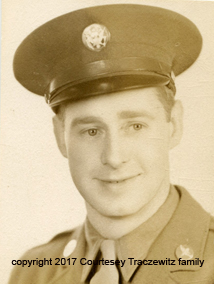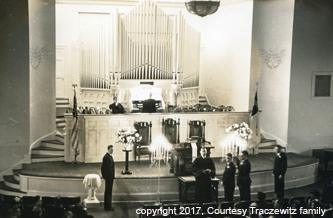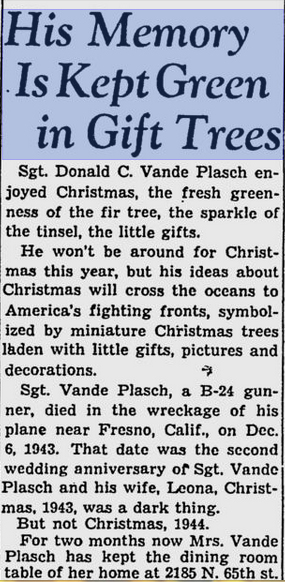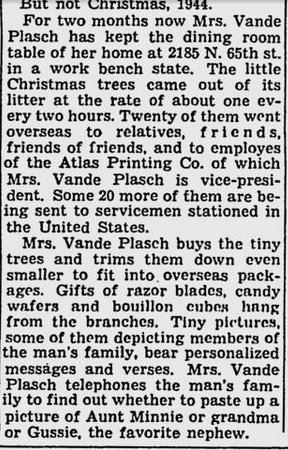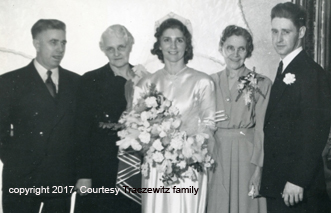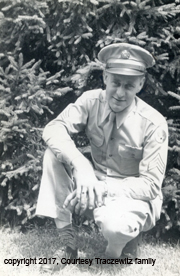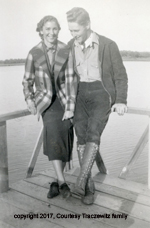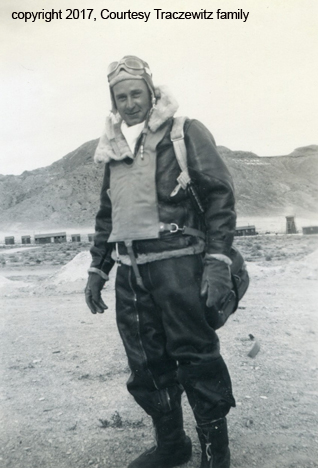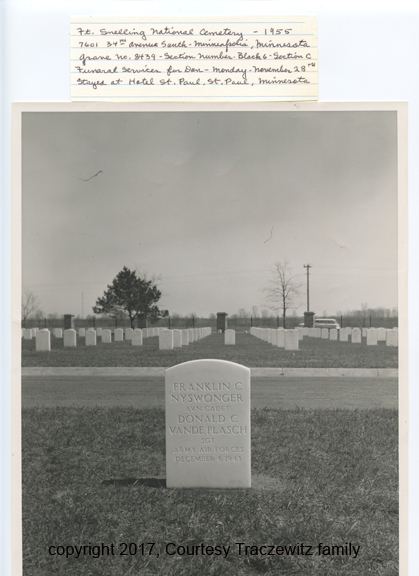|
|
|
Donald C. Vande Plasch
|
|
Donald C. Vande Plasch from Wauwatosa, Wisconsin. The 5'9"
160 pound staff sergeant was a gunner on Exterminator. Born May 29,
1913, Vande Plasch was the oldest of the twelve boys from the two missing
B-24 crews, had enlisted on October 28, 1942, and was a married man. He
and Leona Traczewitz had tied the knot December 6, 1941, two years to the
day before Captain Darden tried to ditch Exterminator in the
Huntington Lake reservoir. What an anniversary gift for his wife.
(The groom and best man await the bride) Prostrated by grief at the news of her husband, Lee wrote to her younger brother, Oscar Traczewitz, a twenty-six year old ensign in the Naval Reserve. Though we donít have that letter, it was probably too traumatic a note for anyone to keep, we do have Oscarís reply. The young man had an incredibly good head on his shoulders. That had to have come from his experiences in the war. He began his missive as a young man is wont to do when addressing a beautiful woman, with a lighthearted compliment. Then he launched into the purpose of his letter, which was to console his sisterís grief. "Even your sorrows and woes, they interest me just as much as anything else that concerns you, and thatís a very great deal." Oscarís love for his sister is writ large across the page and gives some kind of indication of how deep Leeís love was in turn for Don. "Happenings like yourís, Lee, are going on all over the world. Many of them have that terrible quality and mixture of doubt and hope and despair that you must feel - Iím sure that certainty (of Donís fate) would bring relief of some sort. Until that certainty comes we must bear up under a terrific strain which eats our hearts out." Here we see what tore Lee up the most, knowing her husband was dead and gone but not knowing what happened or where he could be. There is that need in all of us to bury our dead and Lee Vande Plasch didnít have it. Until she did there could be no closure. Like her husband, Lee was thirty years old in 1943 and must have felt her life now was over, her best years behind her. Her brother, Oscar, disagreed. He addresses Lee by his pet name for her, "Monk, donít think yourself at the end of the road. You are young, younger than your age. You havenít even begun to near the top of the hill in that road of life, which, for some people, never descends." And to deal with her grief, which must have felt terminal, Oscar wrote, "You have so much to live for, so much to strive for, so much to do in this world. Itís the people with drive and energy that keep the world moving in its path of progress. You are part of that group." Finally, acknowledging his sisterís despair, Oscar ends his letter with the only thing possible a person can share in such times. "I wish I could be home with you now," and he signs it, "Your loving brother," and his nickname, "Bud." I have this letter because I was able to track down the son of Oscar George Traczewitz, also Oscar George, known as "Tracey." In a short conversation Tracey told me Lee married Maurice Gale Watts in 1946 and, though they never had children, "She would have made a great mom. Aunty Lee was a sweet person; she was a real special lady."
In addition to graciously loaning the letter to me, Tracey provided wedding photos between Vande Plasch of his beaming and radiantly happy Aunty Lee. The December 9, 1941 issue of the Milwaukee Journal described the wedding party at the First Congregational Church of Wauwatosa. "The bride wore a princess gown of ivory satin and a tiara which held a fingertip veil. She carried a crescent shaped bouquet of white camellias, carnations and snapdragons." Her three bridesmaids wore, "rust velvet gowns and carried dubonnet and pink carnations and shell pink snapdragons." The groomís brother, Melvin, served as best man.
There are two images of Don, one with him posed nonchalantly in his uniform, his sergeantís stripes prominently displayed. The other is a formal portrait.
My favorite photo of the batch, though, is of Lee and Don, dressed in rough clothing, standing on a wooden platform with a lake behind them. Donís thick, sandy-colored, wavy hair is combed back tight and Leeís long, curly hair is drawn behind her head. Theyíre both smiling broadly, Lee looking straight at the camera and Don with his glance downward. Itís as if the photographer has caught them in the immediate instant of laughter or expression of joy.
Another of the images shows Don Vande Plasch in his fur-lined high altitude flight suit, complete with Mae West and seat-type parachute. The desolate background with some ramshackle buildings can only be Wendover, Utah, where most of the Hammer Field boys were stationed for brief training before moving on to California.
One final black and white photo in the small stack sent to me is of the headstone shared by Don Vande Plasch and Clark Nyswonger. The stone stands forlornly by itself. Behind it is a road and behind that, more headstones and the cemetery fence. Beyond that is nothing by sky.
On November 15, 1955 Mr. and Mrs. Vande Plasch had received the same telegram sent to Mrs. Marguerite Nyswonger. "Due to the nature of the airplane crash and the condition of the remains it is impossible to identify remains of Sgt. Vande Plasch from remains of one other individual in the crew. Remains of your late son and remains of the other crew member will be interred in one grave in Fort Snelling National Cemetery." The interment was a small affair. The Vande Plasch family was there. So was Leona Traczewitz Vande Plasch Watts and her second husband. They had traveled eight hours by train from Wauwatosa, spending the nights of November 27 and 28, 1955 at the Hotel St. Paul in St. Paul, Minnesota. All so she could say her final goodbye. Maurice Gale Watts must have been quite a guy to be there too.
|
| | Home | The Crews | B-24 Liberator | Media | Links | Images| |
| | The Author | Books by Peter Stekel | Press Packet | Contact | |
|
|Extended end notes from Beneath Haunted Waters|
|
|
copyright 2017 by Peter Stekel - all rights reserved |

